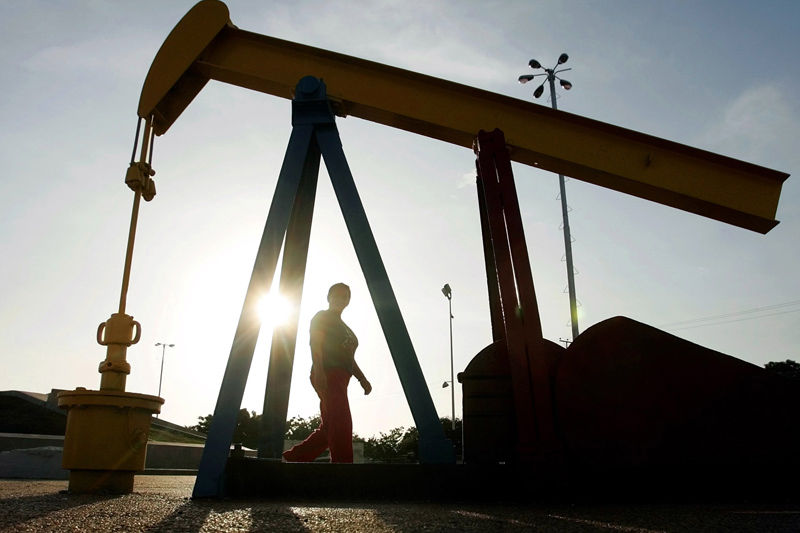Investing.com - Crude oil futures held on to strong gains during U.S. morning trade on Thursday, after a U.S. government report showed oil supplies fell significantly last week.
Prices were also higher after European Central Bank President Mario Draghi unveiled details of the banks bond purchasing program earlier in the day, aimed at easing the debt crisis in the region.
On the New York Mercantile Exchange, light sweet crude futures for delivery in October traded at USD97.34 a barrel during U.S. morning trade, rallying 2.1%.
Earlier in the day, prices rose by as much as 2.35% to trade at a session high of USD97.71 a barrel, the strongest level since August 27.
The U.S. EIA said in its weekly report that U.S. crude oil inventories fell by 7.4 million barrels in the week ended August 31, compared to expectations for a decline of 5.3 million barrels.
Total U.S. crude oil inventories stood at 357.1 million barrels as of last week.
Total motor gasoline inventories decreased by 2.3 million barrels, compared to expectations for a decline of 3.4 million barrels.
Oil prices were higher ahead of the data after ECB President Draghi said the central bank would launch an "outright monetary transaction", or OMT, program in the secondary market, which he said will provide "a fully effective backstop" against market volatility.
Draghi said "strict and effective conditionality” was an essential element of the plan, under which the ECB would buy unlimited amounts of bonds of up to three years in maturity.
The ECB will decide on when bond purchases will start and how long they will continue after a “full assessment”.
The comments came after the central bank left its key lending rate unchanged at a record-low of 0.75%.
Oil prices found further support after payroll processing firm ADP said U.S. non-farm private employment rose by a seasonally adjusted 201,000 in August, easily surpassing expectations for an increase of 140,000.
The previous month’s figure was revised up to a gain of 173,000 from a previously reported increase of 163,000.
A separate report showed that the number of people who filed for unemployment assistance in the U.S. last week fell by a more-than-expected 12,000 to a seasonally adjusted 365,000, compared to expectations for a decline of 7,000 to 370,000.
Also Thursday, the U.S. Institute of Supply Management said that service sector activity in the U.S. grew at a faster rate than expected in August, hitting the highest level since May.
Market players now looked ahead to Friday’s crucial report on non-farm payrolls, which will allow investors to further gauge the strength of the labor market and the need for additional easing by the Federal Reserve.
The U.S. is the world’s biggest oil-consuming country, responsible for almost 22% of global oil demand.
Elsewhere, on the ICE Futures Exchange, Brent oil futures for October delivery rose 1.5% to trade at USD114.78 a barrel, with the spread between the Brent and crude contracts standing at USD17.44 a barrel.
Prices were also higher after European Central Bank President Mario Draghi unveiled details of the banks bond purchasing program earlier in the day, aimed at easing the debt crisis in the region.
On the New York Mercantile Exchange, light sweet crude futures for delivery in October traded at USD97.34 a barrel during U.S. morning trade, rallying 2.1%.
Earlier in the day, prices rose by as much as 2.35% to trade at a session high of USD97.71 a barrel, the strongest level since August 27.
The U.S. EIA said in its weekly report that U.S. crude oil inventories fell by 7.4 million barrels in the week ended August 31, compared to expectations for a decline of 5.3 million barrels.
Total U.S. crude oil inventories stood at 357.1 million barrels as of last week.
Total motor gasoline inventories decreased by 2.3 million barrels, compared to expectations for a decline of 3.4 million barrels.
Oil prices were higher ahead of the data after ECB President Draghi said the central bank would launch an "outright monetary transaction", or OMT, program in the secondary market, which he said will provide "a fully effective backstop" against market volatility.
Draghi said "strict and effective conditionality” was an essential element of the plan, under which the ECB would buy unlimited amounts of bonds of up to three years in maturity.
The ECB will decide on when bond purchases will start and how long they will continue after a “full assessment”.
The comments came after the central bank left its key lending rate unchanged at a record-low of 0.75%.
Oil prices found further support after payroll processing firm ADP said U.S. non-farm private employment rose by a seasonally adjusted 201,000 in August, easily surpassing expectations for an increase of 140,000.
The previous month’s figure was revised up to a gain of 173,000 from a previously reported increase of 163,000.
A separate report showed that the number of people who filed for unemployment assistance in the U.S. last week fell by a more-than-expected 12,000 to a seasonally adjusted 365,000, compared to expectations for a decline of 7,000 to 370,000.
Also Thursday, the U.S. Institute of Supply Management said that service sector activity in the U.S. grew at a faster rate than expected in August, hitting the highest level since May.
Market players now looked ahead to Friday’s crucial report on non-farm payrolls, which will allow investors to further gauge the strength of the labor market and the need for additional easing by the Federal Reserve.
The U.S. is the world’s biggest oil-consuming country, responsible for almost 22% of global oil demand.
Elsewhere, on the ICE Futures Exchange, Brent oil futures for October delivery rose 1.5% to trade at USD114.78 a barrel, with the spread between the Brent and crude contracts standing at USD17.44 a barrel.
